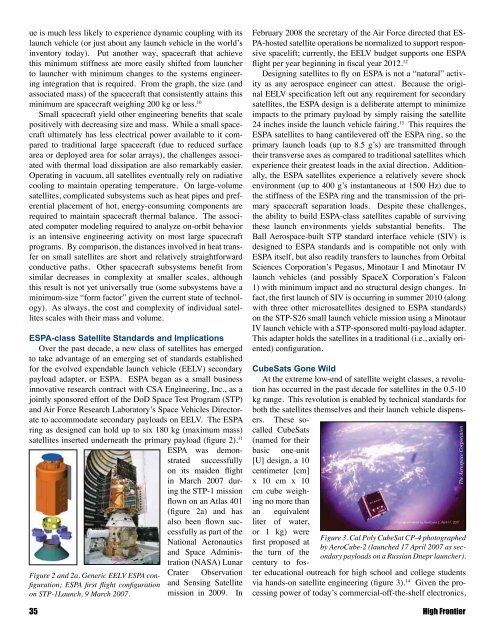ue is much less likely to experience dynamic coupling with itslaunch vehicle (or just about any launch vehicle in the world’sinventory today). Put another way, spacecraft that achievethis minimum stiffness are more easily shifted from launcherto launcher with minimum changes to the systems engineeringintegration that is required. From the graph, the size (andassociated mass) of the spacecraft that consistently attains thisminimum are spacecraft weighing 200 kg or less. 10Small spacecraft yield other engineering benefits that scalepositively with decreasing size and mass. While a small spacecraftultimately has less electrical power available to it comparedto traditional large spacecraft (due to reduced surfacearea or deployed area for solar arrays), the challenges associatedwith thermal load dissipation are also remarkably easier.Operating in vacuum, all satellites eventually rely on radiativecooling to maintain operating temperature. On large-volumesatellites, complicated subsystems such as heat pipes and preferentialplacement of hot, energy-consuming components arerequired to maintain spacecraft thermal balance. The associatedcomputer modeling required to analyze on-orbit behavioris an intensive engineering activity on most large spacecraftprograms. By comparison, the distances involved in heat transferon small satellites are short and relatively straightforwardconductive paths. Other spacecraft subsystems benefit fromsimilar decreases in complexity at smaller scales, althoughthis result is not yet universally true (some subsystems have aminimum-size “form factor” given the current state of technology).As always, the cost and complexity of individual satellitesscales with their mass and volume.ESPA-class Satellite Standards and ImplicationsOver the past decade, a new class of satellites has emergedto take advantage of an emerging set of standards establishedfor the evolved expendable launch vehicle (EELV) secondarypayload adapter, or ESPA. ESPA began as a small businessinnovative research contract with CSA Engineering, Inc., as ajointly sponsored effort of the DoD <strong>Space</strong> Test Program (STP)and <strong>Air</strong> <strong>Force</strong> Research Laboratory’s <strong>Space</strong> Vehicles Directorateto accommodate secondary payloads on EELV. The ESPAring as designed can hold up to six 180 kg (maximum mass)satellites inserted underneath the primary payload (figure 2). 11ESPA was demonstratedsuccessfullyon its maiden flightin March 2007 duringthe STP-1 missionflown on an Atlas 401(figure 2a) and hasalso been flown successfullyas part of theNational Aeronauticsand <strong>Space</strong> Administration(NASA) LunarFigure 2 and 2a. Generic EELV ESPA configuration;ESPA first flight configurationon STP-1Launch, 9 March 2007.Crater Observationand Sensing Satellitemission in 2009. InFebruary 2008 the secretary of the <strong>Air</strong> <strong>Force</strong> directed that ES-PA-hosted satellite operations be normalized to support responsivespacelift; currently, the EELV budget supports one ESPAflight per year beginning in fiscal year 2012. 12Designing satellites to fly on ESPA is not a “natural” activityas any aerospace engineer can attest. Because the originalEELV specification left out any requirement for secondarysatellites, the ESPA design is a deliberate attempt to minimizeimpacts to the primary payload by simply raising the satellite24 inches inside the launch vehicle fairing. 13 This requires theESPA satellites to hang cantilevered off the ESPA ring, so theprimary launch loads (up to 8.5 g’s) are transmitted throughtheir transverse axes as compared to traditional satellites whichexperience their greatest loads in the axial direction. Additionally,the ESPA satellites experience a relatively severe shockenvironment (up to 400 g’s instantaneous at 1500 Hz) due tothe stiffness of the ESPA ring and the transmission of the primaryspacecraft separation loads. Despite these challenges,the ability to build ESPA-class satellites capable of survivingthese launch environments yields substantial benefits. TheBall Aerospace-built STP standard interface vehicle (SIV) isdesigned to ESPA standards and is compatible not only withESPA itself, but also readily transfers to launches from OrbitalSciences Corporation’s Pegasus, Minotaur I and Minotaur IVlaunch vehicles (and possibly <strong>Space</strong>X Corporation’s Falcon1) with minimum impact and no structural design changes. Infact, the first launch of SIV is occurring in summer 2010 (alongwith three other microsatellites designed to ESPA standards)on the STP-S26 small launch vehicle mission using a MinotaurIV launch vehicle with a STP-sponsored multi-payload adapter.This adapter holds the satellites in a traditional (i.e., axially oriented)configuration.CubeSats Gone WildAt the extreme low-end of satellite weight classes, a revolutionhas occurred in the past decade for satellites in the 0.5-10kg range. This revolution is enabled by technical standards forboth the satellites themselves and their launch vehicle dispensers.These socalledCubeSats(named for theirbasic one-unit[U] design, a 10centimeter [cm]x 10 cm x 10cm cube weighingno more thanFigure 3. Cal Poly CubeSat CP-4 photographedby AeroCube-2 (launched 17 April 2007 as secondarypayloads on a Russian Dnepr launcher).an equivalentliter of water,or 1 kg) werefirst proposed atthe turn of thecentury to fostereducational outreach for high school and college studentsvia hands-on satellite engineering (figure 3). 14 Given the processingpower of today’s commercial-off-the-shelf electronics,The Aerospace Corporation35 High Frontier
Figure 4. NASA Ames GeneSat-1(launched 16 December 2006) as a secondarypayload on a US Minotaur Ilaunch.these tiny satellites areenormously more powerfulthan the early Explorer,Vanguard, andPioneer satellites. Thecost to build CubeSatsis incredibly inexpensive—from$25,000(a basic kit design anddo-it-yourself labor)up to $1-5 millionfor complicated USgovernment scientificprojects (with laborand testing as the costdriver)(figure 4). The cost to launch a CubeSat as a secondarypayload is also cheap, typically running from $50,000 to$70,000 for a 1U CubeSat. These satellites are today equippedwith miniaturized global positioning system (GPS) receivers,cell-phone digital cameras, reaction wheels, radio transceiversand microprocessors running mobile-device operating systems.Larger 3U CubeSats taking advantage of the full volume of astandard California Polytechnic State University (CalPoly)-Picosatellite Orbital Deployer (P-POD) can now be equippedwith deployable solar arrays, antennas, and cold-gas propulsionsubsystems. 15 Available power is roughly one watt per 1U cubeof surface area, with roughly 1.5 megabit per day of downlinkcapacity. 16A major advantage of CubeSats is their unobtrusiveness tothe launch vehicle integration process. A full P-POD weighsjust slightly over 5 kg and requires a simple electrical initiationsignal to activate a resistive-actuator door release (the satellitesthemselves are deployed from the P-POD using a simplespring) (figure 5). The genius of the P-POD is the containerizationof the CubeSats within a deployment device qualifiedto NASA Standard 7001 mechanical workmanship standards. 17In essence, the P-POD serves as a “shipping container” thatprevents even a catastrophic CubeSat structural failure fromescaping the P-POD and damaging the launch vehicle duringflight. 18 Even more importantly, the small size and mass of aFigure 5. NASA Ames GeneSat-1 loaded into P-POD.P-POD greatly simplifies the launch vehicle CLA process ascompared to larger satellite payloads. Whereas even microsatellitesstill require detailed computer finite element models(FEM) to numerically approximate a complex system, the P-POD is like a flea on the back of an elephant—CubeSats canbe modeled with a simple mass-spring-dashpot approach thatoutputs a relatively straightforward (and deterministic) transferfunction. This dramatically shortens the time required for CLAcompared to normal FEM computer simulations.Critics have argued that CubeSats are nothing more than toys.The rapid growth in small satellite technology over the past decade(approximately 30 CubeSats launched since 2003) challengesthis view through the on-orbit demonstration of growingCubeSat utility in scientific and military endeavors. Today over50 universities worldwide have active CubeSat programs. 19Various US scientific, defense technology and industry Cube-Sat efforts are also underway. Leading organizations includeNASA, the DoD <strong>Space</strong> Test Program (STP) within SDTW, theNational Science Foundation, the National ReconnaissanceOffice, CalPoly, AFRL, NRL, US Naval Postgraduate School,US Army <strong>Space</strong> and Missile Defense Center, the <strong>ORS</strong> Office,and Boeing Phantom Works. CubeSats’ small size, low-cost,and ease of construction have contributed to their proliferationacross the aerospace industry. Current example missions includein-situ space weather monitoring, technology maturation,astrobiology, atmospheric density measurement, and beyondline-of-sight communications. Additional efforts are ongoingto expand CubeSat capabilities into medium-resolution earthsensing, unmanned ground sensor data exfiltration, tacticalelectronic support, and humanitarian relief missions. While itis true that physics may limit what small-sized spacecraft mayachieve in some mission areas (such as large-optic telescopesfor high resolution), the rapid progress achieved to date suggeststhese limits may be overstated by CubeSat detractors.Many analysts have also expressed concern that CubeSatproliferation will greatly contribute to today’s orbital debrischallenges (aka “debris-sat”). Orbital lifetime studies conductedfor representative 1U CubeSats shows that uncoordinatedreentry will normally occur within one year for orbital altitudesless than 275 km, two years at an altitude of 400 km, 10 yearsfor an altitude of 550 km, and 25 years (the US government orbitaldebris mitigation standard) at an altitude of 625 km; however,the addition of an inexpensive 100-meter electrodynamictether weighing less than 0.6 kg can decrease these lifetimes toless than a year for 525 km altitude, 10 years at 800 km altitudeor 25 years at 1000 km height. 20 The DoD STP, NASA andAFRL are currently sponsoring technology development effortsfor other drag enhancing devices (including extensible “sails”for small satellites) that will be demonstrated as early as summer2010. 21 These improvements can substantially mitigateorbital debris concerns.ConclusionThe DoD Strategic Deterrence Joint Operating Concept publishedin 2004 made the following statements on future spacecontrol concepts: 22High Frontier 36
- Page 5 and 6: Going forward, an end-to-end series
- Page 7 and 8: sometimes even the existence of our
- Page 10 and 11: in very-small, low-cost nanosatelli
- Page 12: Senior Leader PerspectiveOperationa
- Page 15 and 16: Operationally Responsive SpaceThe S
- Page 17 and 18: equivalent XTEDS are interchangeabl
- Page 21 and 22: capabilities in a cost effective ma
- Page 23 and 24: Operationally Responsive SpaceOpera
- Page 25 and 26: With regard to precedents involving
- Page 27 and 28: 117-17 Comparison of MILSATCOM Syst
- Page 29 and 30: 4. Technology advances making small
- Page 31 and 32: of excellent proposals from hungry
- Page 33: 2. ORS Office and program element c
- Page 38: These new concepts, when proven, mi
- Page 42 and 43: lance System have yet to be fielded
- Page 44 and 45: the perpetrating nation will be dif
- Page 46: porting architectures would be sepa
- Page 49 and 50: velopment path, and enable more rap
- Page 51: Equipment and hardware standardizat
- Page 54 and 55: education foundation and a locker r
- Page 56 and 57: to transform their 20+ cadets in th
- Page 58 and 59: for further experimentation support
- Page 60 and 61: Figure 1.President JohnF. Kennedybe
- Page 62 and 63: ked eye, the Agena was released, an
- Page 64 and 65: Figure 4. Gemini VI crew of Tom Sta
- Page 68 and 69: to bring fuel or generators into an
- Page 72 and 73: sponse, environmental disasters, ag
- Page 74 and 75: ing that systems remain on the Euro
- Page 76 and 77: above Falcon 1e and Falcon 9 prices
- Page 78 and 79: selected; FAA personnel reviewed th
- Page 80 and 81: final position adjustment for a pro
- Page 82 and 83: it provides a long dwell time in mi
- Page 84 and 85: Industry PerspectiveBenefits of Ret
- Page 86 and 87:
to launch vehicle issues, TacSat-2
- Page 88 and 89:
eight years since the effort was st
- Page 90 and 91:
tivities of the DoD and the intelli
- Page 92 and 93:
Cost uncertainty associated with es
- Page 94 and 95:
stream space acquisition community.
- Page 96:
• Demonstrated low risk and matur
- Page 100:
is changing now as the STP receives
- Page 103 and 104:
Book ReviewThe New Space Race: Chin











